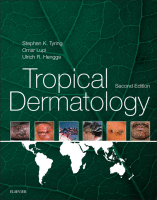Physical Address
304 North Cardinal St.
Dorchester Center, MA 02124

Key Points Environment and genetics may result in an altered clinical presentation of common viruses in the tropics. Epstein–Barr virus (EBV) can cause infectious mononucleosis, oral hairy leukoplakia, and chronic active EBV infection. EBV can also cause nasopharyngeal carcinoma, Burkitt's…

Key Points HTLV-1. Tropical spastic paraparesia. Infective dermatitis. Crusted scabies. Adult T-cell leukemia lymphoma. Introduction The human T-lymphotropic virus 1 (HTLV-1) was the first retrovirus identified, even before the human immunodeficiency virus (initially called HTLV-3). It is a delta retrovirus…

Key Points Measles is a highly contagious mucocutaneous disease caused by the measles virus. It is one of the most important infectious diseases of humans, responsible for millions of deaths prior to the development of measles vaccines. It manifests as…

Introduction Since the last natural smallpox infection, reported in Somalia in 1977, human poxvirus infections (other than molluscum contagiosum) have only been observed sporadically either after vaccination with poxvirus officinalis (vaccinia virus), or due to zoonotic poxviruses, such as monkeypox,…

Key Points Arenaviruses and hantaviruses are systemic viral diseases that are closely related to hemorrhagic fevers. Both groups of viral hemorrhagic fevers are shed in the infected rodent's saliva, urine, and feces. Ebola infection is the most aggressive viral hemorrhagic…

Introduction The pandemic of human immunodeficiency / acquired immunodeficiency syndrome (HIV / AIDS) is proving to be a modern scourge. The sheer magnitude of the problem can be understood, to some extent, by looking at the figures in Tables 11-1 and 11-2 . There…

Key Points Infection takes place by skin contact with Schistosoma cercariae-infested water. Three clinical stages with distinctive skin manifestations are successively related to the different stages of infection: First stage (cercarial dermatitis): pruritic maculopapular rash at the site of penetration…

Key Points Tapeworms cause disease in humans in either of the two stages of their life cycle: the adult stage, which takes place in the intestines, where it causes mild or non-existent clinical manifestations, and the larval stage, which causes…

Introduction Nematodal Helminths Nematodal helminths represent infectious agents that are not very infectious, but have developed a delicate strategy to infect human hosts. As such, they manage to overcome the epidermal barrier, enter the human body, and travel by several…

Filariasis Sam Kalungi Lynnette Tumwine Key Points The filariases result from infection with insect-vector-borne tissue-dwelling nematodes. This group of nematodes is characterized by having a microfilaria stage of development between the egg and the fully developed larva. Depending on the species, adult…